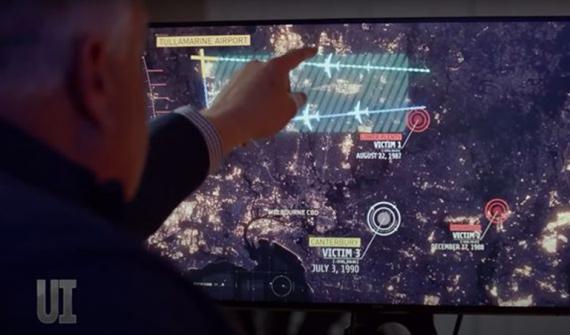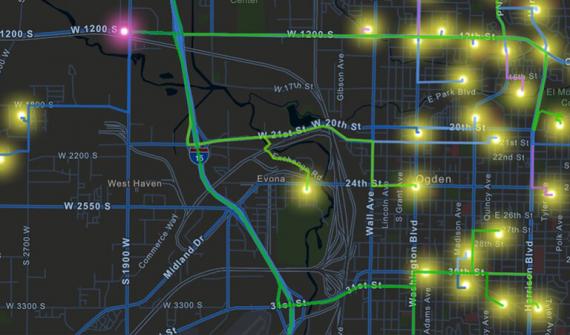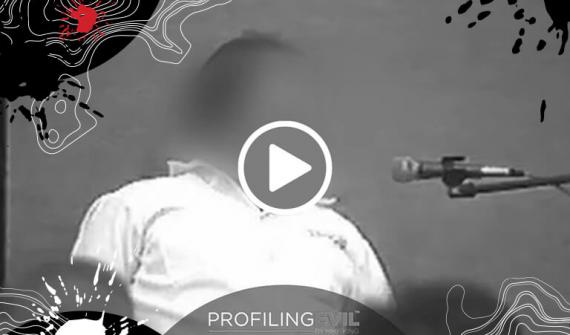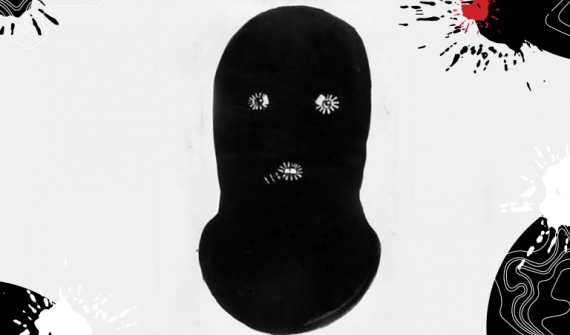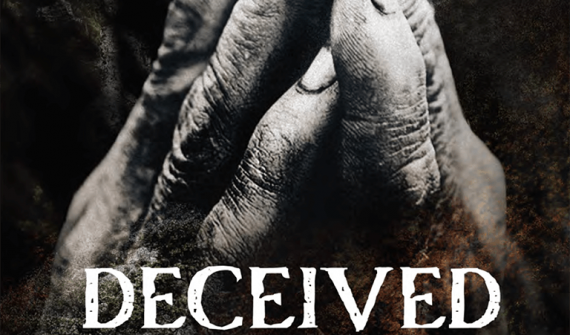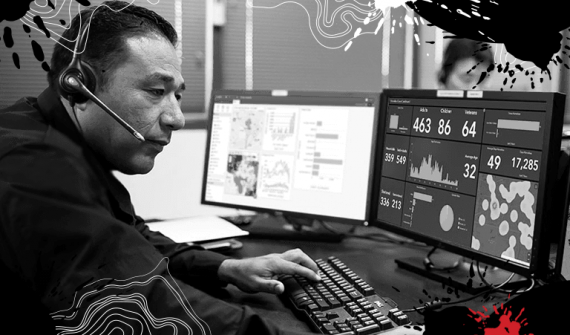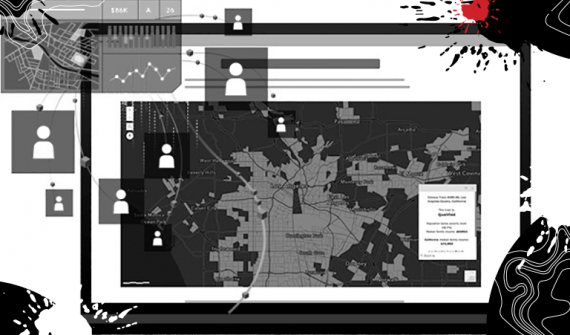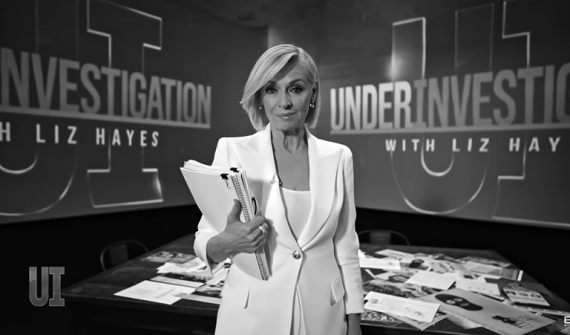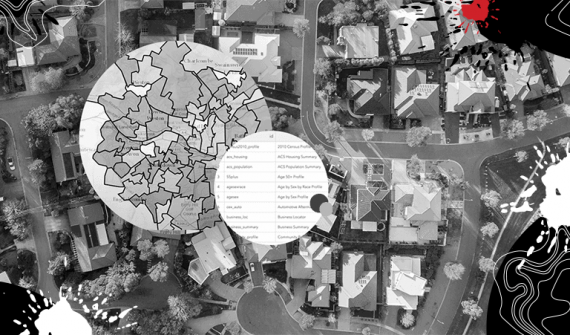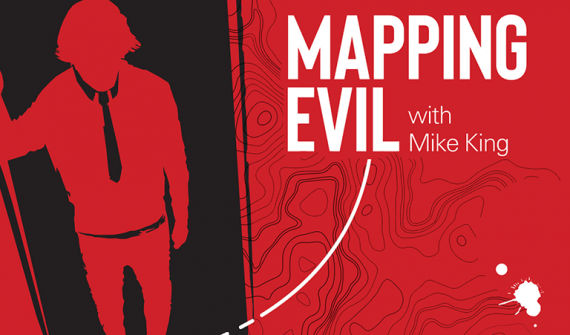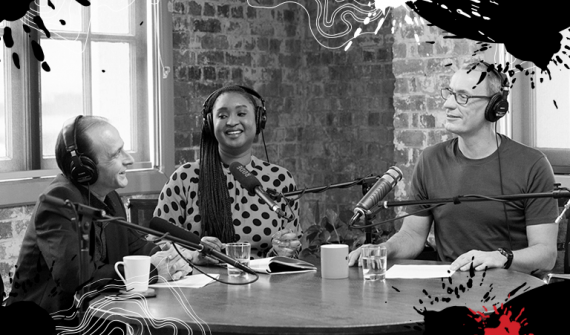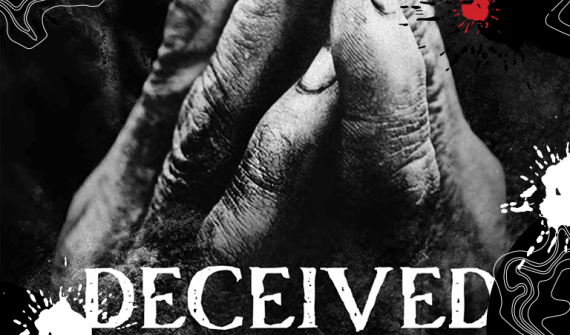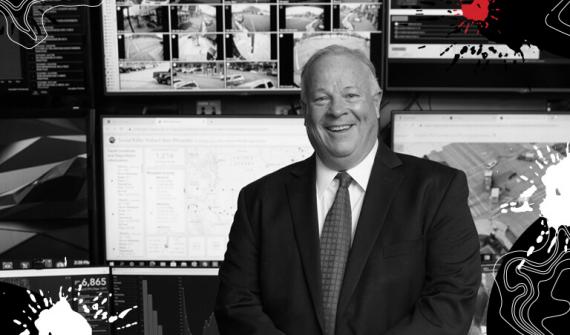Exploring where cruelty blooms
Join Mike King and Tory Shepherd as they unpack the crimes of two of the most malevolent human beings to ever draw breath: Utah’s Blaine Hogge Nelson – suspected of 70 to 80 rapes across 11 states – and Australia’s own Boogieman, Mr Cruel.
Walk with King as he dramatically retraces the steps of both Nelson and Cruel – exploring what the geography of their crimes truly reveals about these sadistic serial predators.
Understand the difference today’s crime analytics techniques and cutting-edge technology could have made to investigators during the predators’ reign of terror.
And be completely creeped out when Mike shares the super-helpful tips given to him by Blaine Hogge Nelson himself on how to limit your chance of becoming a victim.
Don’t miss this episode of Mapping Evil with Mike King…
“…there's this weird psychology in prisoners or in inmates, specifically in serial predators. They want a legacy. Some of those people, the legacy is to be the most prolific serial predator known to man.”
Discover more crime mapping tech
Never miss an episode of Mapping Evil – subscribe now.
About the hosts
Get started with a free trial of Esri's mapping software.

If you have information about any unsolved crime or suspicious activity, then you can share what you know with Crime Stoppers, without saying who you are or getting involved. Call 1800 333 000 – or go to crimestoppers.com.au.
- Click to view The Delicate Landscape of Victim and Predator transcript
Tory: The following podcast contains content of a highly graphic nature. Listener discretion is advised. The material covered is based on firsthand accounts and publicly available information. In producing this podcast, every effort has been made to show respect to the victims and their families. Support for this episode comes from the country's leading mapping technology and services provider, Esri Australia, to learn more about how Esri tech is making a difference in crime analysis and public safety, head to Esri Australia that's E S R I australia.com.au/crime.
I'm Tory Shepherd. And this is Mapping Evil with Mike King.
Mike: Prior to the problem with these serial predators is the mobility factor. This individual committed 70 or 80 rapes in 11 different States.
Tory: The podcast that explores the complex terrain of criminal profiling and carefully navigates the geography between predators and their victims.
Mike: He had a bicycle in his truck and he would pull his 18-wheeler off the road and he would ride his bicycle a mile into a community where he would commit the sexual assault, and then get back out to the highway and throw his bike in the truck and disappear.
Tory: Episode Six: The Delicate Landscape of Victim and Predator.
Today, we'll be going on a fascinating and at times confronting journey with the star of our show, Mike King.
Mike, you've spent 28 years working in law enforcement. You're a published author and you've spoken all over the world about how geographic insight has helped you solve cases. You've investigated some of America's most horrific crimes, but I want to take you back to one case in particular.
It was the 1980s. And a serial rapist, a man who raped 70 women across America had you and your law enforcement colleagues desperately trying to stop his reign of terror.
Mike, tell us about this predator and his modus operandi.
Mike: You know, one of the things that was so unique about him was that he, well, number one, it was the victim selection process that he went through.
He was focused on women that were about 25 to 35 years of age. His preferential victim was a divorcee who had small children at home, and what he had constructed in his mind, which actually worked quite well for him, was that many of these women were on a low-income. They were either divorced or recently divorced, having a difficult time managing the bills.
And so they were living in homes that were less secure than other homes that many of us would have. His preferential time to commit rapes was in the summertime, and so often they didn't have the money to pay for central air conditioning, and so they would leave their windows cracked open, which gave him easy access into the room at night.
He really read and understood victimology. And it was kind of an innate thing, and we see this in many serial predators, and we see a kind of a personality in serial predators that is very unique, but consistent across the board. What happens is, a sexual predator like this fellow, didn't start out as someone who is breaking into homes and raping, he started in his teenage years and was peeking through windows and as he peeked through the windows, he would fantasise about the victim, but there's a really amazing thing that happens.
Fantasy fuels reality. And so as he continues to fantasise about having experiences with these unknowing victims, he continues to think about and fantasise, and eventually the fantasy's not good enough. And they have to then act out the fantasy.
And this is what really starts the real difficult thing in serial crimes, because as soon as they act out the fantasy, the victim fights back or refuses or cries. And that behaviour doesn't fit the fantasy of these predators. And they may continue on with the sexual assault to just self-gratify and then move on.
But because the victim didn't act the way that they'd been fantasising about, they have to go home and repair in their mind what went wrong and then they start fantasising and rethinking about how they would fix that, and that then leads them again, the fantasy builds and it leads them to acting out again.
Tory: So, this is amazing cause I guess we always think of these people as being so inhuman that they would have a reasoning process we could barely understand, but you can start mapping this guy and how he's targeting people through the demographics of the people, through their situation in life, like being a divorcee.
But what does that say about the victimology?
Mike: Yeah there are some really interesting things that come out of this that, from a process of trying to reduce our own victimisation we can learn from. First, as investigators, we could start to look at the locations where these sexual assaults were occurring. And as a serial predator repeats those same kinds of behaviours, we can start tying cases together and attributing them to the same perpetrator.
That gives us the ability to then look at things like the demographic of the victim, you know, the race, the victim selection process of, do they like people with brown hair or blonde hair? Do they like thin people or heavier people? All of those things become very important in understanding who the offender is.
But then as we start looking at the demographics beyond the individual, like the kind of housing that they live in, we can start to look to other places in our communities that might have similar kinds of housing units. And it can give us an opportunity from a law enforcement perspective to do things like community policing efforts, where we can notify people in those areas that these are things you can do to secure yourself more efficiently or effectively.
But more importantly, as sexual assaults occur, we can look at those behaviours and link them together. And sadly, the more times an offender strikes, the better chance we have of capturing them because we start to learn who they are. And that's what really leads to being able to capture people.
Tory: That's fascinating, so it's like a layering of data and information, and as you get the crossovers between the different crimes, I can see then how the picture of this guy kind of emerges. So I just want to tease out another thing about him. He had a creepy reaction to lilacs.
Mike: Some of his first experiences of window peaking were occurring in the springtime when the lilac bushes were blossoming, and those incredible vibrant smells were out there. Well, what happened is this person was going through this process of being stimulated by looking through the windows, and subconsciously was equating that to the smell of lilacs.
And so every spring time, when the lilacs would start to bloom, he would start to get this hunger to go out and find another victim. When we started understanding that, we started looking more closely at the olfactory responses and, and how our minds are triggered.
Now, imagine for a sexual predator, who like a drug addict is fueling their mind with these sensations of sexuality. And this triggering effect of lilacs happens. This a change of behaviour that's just stimulated by a simple thing. Like the blooming of lilacs.
Tory: There's a special horror, I guess, in the beauty of a flower and the horror of the deed.
But does that become, then a thing where you can add that into a map. Here are the poorer households and here a whole lot of lilacs. And again, you can start to keep building that picture.
Mike: Yeah, that's really an interesting thing and of course we didn't have the opportunity in that case, because again, we didn't realise it until after the fact, but if we would start looking at the things that are not being said in an investigation, instead of always focusing on what's being said, we might start to see an image come to the surface of who these individuals are that we're pursuing.
And as we do that, we can start to think a little more outside of the box. And we've seen this lately with simple things like narcotics investigations, where certain plants that are grown emit a certain chemical into the air. Well flying over those regions where we think there might be marijuana grows or other kinds of things, and having a drone with sensors on it that could just pick up those fragrances, can lead us to the more probable locations to look for crime, instead of just trying to figure out across the huge landscape where something might be occurring.
Tory: Amazing. Now one of his other little habits was that he liked to hang around after he'd committed these acts. So he'd sort of run away, but then he'd come back just to see the reaction. And you've started building up this picture, but then you've got to close that noose, right? You've got to bring this guy in. How does it all start coming together to target this particular criminal?
Mike: Well, one of the things that we figured out over time was that this particular offender, two really interesting behavioural characteristics emerged. One had to do with the sexual assault itself. If, in the course of the sexual assault, certain demands were made and then not met by the victim, the offender would still complete the assault. He's still a predator and he's still evil, and made these decisions. But he would then flee the area, and if he was denied certain things in an order in which he wanted those to happen, again, think about the fantasy, he would then, within a couple of hours re-offend and attempt to rape someone else.
That became very significant because what it meant was that by simply changing the interview strategy of the responding officers, when they met with the victim, and instead of doing the normal things, explaining to them how important it was to ask a simple question, what occurred, what was the order of what occurred?
And then when those cases occurred where the individual fought back or didn't comply, we knew that based on that, that the offender would re-offend within a couple of hours in the general area. And so we would just immediately call out all the troops and we would put people out in plain clothes, walking the street with dogs and trying to appear like just citizens on the street. And then we were stopping and shaking down everybody that we could possibly shake down.
Tory: So eventually you got him, using this new way of thinking about crimes, of building up of mapping, this guy's character and actually mapping the area you caught Blaine Hogge Nelson.
So he was 33 year old truck driver when he committed all these crimes across Utah. Now he's 65. He's serving three, 15 years to life sentences. And if he ever gets out, he's actually got a whole other life sentence waiting for him in Wyoming. Is that right?
Mike: That's correct.
Tory: He's not getting out. So you met this guy. 10 years later, you start tracking down these horrendous crimes and then you're visiting him in prison. What's it like after having tried to get inside his head like that to actually have a conversation with him?
Mike: I was actually serving in the attorney General's office by the time this happened. And what we had determined was that, we continued to teach classes on how to investigate serial crimes, but we were leaving out a very important component. The expert.
And so, we went into the prison system and tried to find a number of serial offenders and convince them that it would be a good thing if they were to meet with law enforcement and share their tactics and techniques and the things that they did in order to be successful. Some inmates just declined, very angrily at times, others, especially those who were facing life sentences, realised that their opportunity to offend had now passed.
And there's this weird psychology in prisoners or in inmates, specifically in serial predators. They want a legacy. Some of those people, the legacy is to be the most prolific serial predator known to man. Others may try to minimise the number of assaults that they have committed, but for all of them, legacy was important.
And what we did is we offered them an opportunity for legacy, to be known as one who tried to also change or correct some of the things they did wrong. And so with that in mind, a number of them agreed to speak, and we would fill auditoriums at the prison training offices with 500 police officers who would come in to listen to these serial predators talk about their victim selection process. Their methodology of committing the crime, what they did to ensure success and get away with it.
But something really peculiar happened along the way, too. I found that they were a treasure trove of information on other cases that I couldn't solve. And oftentimes I would go into prison and we'd have prison lasagna and sit and talk and I'd tell them about a case I was working. And I’d just say, what would you have done? And the insight that they would share was absolutely extraordinary.
Tory: It's just extraordinary, but also a little bit Hannibal Lecter, you know, having the investigator actually talk directly to the criminal, cause I guess our preconception would be the criminals would all band together against law enforcement, but it's more like their egos overrode that.
Back to Nelson. You've talked to him. You've learned more about him. One of the interesting things to me is that he's a truck driver. So how did that fit into the way that you started to get to know where he was going to strike next?
Mike: Yeah, that was a real challenge because in those years we weren't doing mapping the way we are today. Prior to the problem with these serial predators is the mobility factor. This individual committed 70 or 80 rapes in 11 different States. He travelled a lot of ground between each of these assaults, but he didn't need to travel that far for agencies not to be aware that their case was similar to the one next door, because law enforcement, at least in the United States, traditionally did not do a great job of communicating or coordinating investigations.
So simply going across jurisdictional lines gives an offender the ability to have an anonymity. And one jurisdiction may look at a crime as a single episode, when, if they were to travel a mile across city boundaries, they would see that it's a serial predator involved in these kinds of things. So it's really important as we look at today's technology, to think of the value that location can play in these kinds of situations.
Number one, being able to identify and share through common databases, serial offences that are similar in nature. We have those kinds of databases in many countries throughout the world now, that give us the ability to say, we're going to track on solve sexual assaults. All unsolved homicides, all unsolved missing persons and have a database that investigators, when they discover a body on a roadside or they have a homicide that they can't solve, can reach out and get support from neighbouring agencies.
Then we need to look at the geography of each of those and start to understand, what are the commonalities between these cases? In this particular case, where we were looking at demographic home values for instance. Once we started looking at other homes that were similar along freeway systems, as we came to know who our offender was, we then were able to start mapping the most probable areas where this offender would have success.
It wasn't until he was arrested that we discovered he had a bicycle in his truck, and he would pull his 18-wheeler off the road and he would ride his bicycle a mile into a community where he would commit the sexual assault. And then get back out to the highway and throw his bike in the truck and disappear.
Well, for local police, they look at that as again, a local geographic challenge. This crime was committed, who in our community did this, instead of thinking about the mobile offender and the fact that they might be coming from a different jurisdiction. And so as we start to bring these together with today's capabilities with geography, we can now start to map those out and say, oh, wow, not only were there victims that were similar, the methodology employed by the offender to break into the home and to assault the individual.
The order in which they demanded certain things happened during the assault, what things were demanded, all of those start to come together. And you know, the cool thing about maps is everything is a dot on the map. Whether it's the location that, that offender lived, where Blaine Nelson cashed his check each week when he got it, where he fueled his truck, every weigh station that he went through and weighed his truck was a record that was a geographic dot on the map. And the value of mapping in these criminal investigations is huge because no longer do we just say, well, it's just a dot on the map. We say, hey, every dot's important, we just need to have the ability to analyse it and understand why this dot is important to that dot. And that really helps us speed up the process of identifying these predators.
Tory: So just quickly, I'm picturing you in the 1980s with Nelson I don't know, sending off faxes, maybe like having some pins and string up on an actual map, and then you sort of fast forward to the work you do now, if you could take some of that technology you now use back then, what kind of a difference would that have made?
Mike: Oh, I would have been promoted to Chief a lot sooner in my career.
Tory: You should have got the DeLorean and gone back with the Esri technology.
Mike: Oh, there's no question. I mean, there are wonderful examples even in the UK, during Jack the Ripper of pin maps identifying the different things that were occurring.
Tory: So, Nelson, you mapped him out, you got his measure. And you got him. And he will never see the light of day. But this technique that you developed, I mean, you know, that's now being used in many, many cases. And I want to talk to you about an Australian case and about how some of these techniques could be useful here. Because there's a criminal who kidnapped, raped and possibly killed little girls in Melbourne. And he was never tracked down.
So Mr. Cruel, the police had a picture of him, but it's just a sketch of a man in a balaclava cause we don't know who he was and they called him the boogeyman. He was just the stuff of nightmares. I'm trying to imagine the horror of parents, of course, the parents of the girls when the kids were taken from their home, often in front of them and also the horror of other parents nearby, wondering where he was going to strike next.
Now, one of the other things that you have done, Mike King, you're also on the board of the cold case foundation, but you've seen plenty of cold cases like this. The Mr. Cruel, the boogeyman and the person who comes and terrorises a community. And is never brought to justice.
Do you think we know everything that Mr. Cruel did from the reports that we've had?
Mike: I don't think we have even an inkling of how many cases he may have been responsible for. There were a couple of things that really stood out to me in this investigation as I looked at it that caused me to think this way.
One is that we see Cruel escalating over time on the victims that we're aware of. It's not a normal behaviour for an offender that's escalating like that to simply stop. We would consider that he either went to prison, perhaps he was in a career that brought him to the Melbourne area periodically. But I don't believe for a moment that this offender wasn't offending more often than the few cases that you're aware of.
And I, and I understand that it could be as many as into the teens that have been superficially linked to him, but the four that we are going to discuss definitely. And it's very obvious in those four cases, that we're seeing an escalation in behaviour and predatory tactics that are being used. So, no, I don't believe that.
Tory: Alright. So look, I'm just going to take you through some of the cases of Mr. Cruel. So we're talking late eighties, early nineties, as I said, in Melbourne. He blindfolded his victim. So in general, they weren't able to give an accurate account of what he looked like, although some of these brave young girls actually peaked around their blindfolds and were able to give police some clues.
So the first one was Sharon Wills. She was 10 years old, from East Ringwood in Melbourne, and she was abducted. Mr. Cruel and his balaclava broke into the house, he demanded money from her parents and took Sharon.
Nicola Lynas was another victim. She was 13 from Canterbury in Melbourne. He broke into the house, armed with a knife and a gun and threatened two sisters before taking one of them, Nicola. Making her bring her school uniform, and he repeatedly assaulted her at an unknown location. Release her after 50 hours.
Karmein Chan, again, 13 years old, she was babysitting, and she was the one that he killed.
So, yeah, we were talking about the escalation. She was found a year later in Edgar's Creek and she'd been shot in the head. So, as you say, they're the ones we know about and that's because you can geographically start to link them all together. You know, there was some strong similarities there.
Mike: So Tory, if we were to step back to the first crime that we know of, of Cruel's, a couple of interesting things happen.
First, I looked at the map and I paid close attention to the aerial imagery and the foliage around the home, the ability for the offender to have concealment. Not necessarily be able to go into the residence and out of the residence without being seen, but to purely be able to peek through the windows and to remain undetected.
The home's covered with a lot of foliage. In three of the four houses that was a consistent behaviour from a geographic standpoint. Each of the homes had quite a bit of trees and other plants around the home. There's a process called CPTED it's called Crime Prevention Through Environmental Design.
And what it does is it helps us to realise that there are certain things we can do in our businesses and in our homes that make them less likely to be targeted by people. One of those is how secluded they are and whether people can hide. That really stood out to me because it shows a level of preparation.
Some of the questions were, is it possible that Cruel identified these victims before he ever knew where they lived? It could have very easily happened that he heard that name or the child may have even said their name and not realised it. Eyewitness accounts are always questionable. So for her to say, well, he just knew my name and we've gone down this rabbit hole thinking that this guy knows who they are when it could be that he just stumbled across the house or saw them at another place.
And what we have in these kinds of investigations are three really different crime scenes that law enforcement needs to consider. The first is called the initial contact site. The first time he focuses in on and starts to fantasise about this child. If in fact that's what happened. But this initial contact site becomes very important because it tells us a lot about the offender and the relationship with the victim.
Then we have crime scenes and the crime scene in this case clearly is that home. But another really peculiar thing in the first case happens, he goes through the effort of removing the windowpane and breaking into the house. He is focused on something inside that house and nothing is going to stop him.
Even parents in the same house are not going to stop him. That shows us a lot of behaviour and a lot of information about that perpetrator. Things that need to be evaluated. He then goes through the process of coming into the home and taking control of the mother and father. And think about your own reaction if something were to happen. What an offender would have to do to immediately gain control of you as a parent, knowing that your family's in jeopardy.
It had to have been an absolutely aggressive assault to take control of those parents. Now, our mindsets would naturally be, I would never want to hurt anyone, so if he tells me he's not going to hurt anyone, I'm going to put my own value system on this offender. A mistake I think we often make as victims because we would never do that to somebody. But he then convinces them that he's going to tie them up and they comply and allow him to tie them up. He ties them up with what appears to be a binding that originates with him. He brings it to the scene.
That tells us a lot about his experience level and his premeditation for this event. What we really want to do is go out and start looking at all the field interrogations that law enforcement’s investigated to see if anyone came across the guy wandering down the street with a pocket full of white athletic tape or hospital tape or whatever the actual tape was.
Then he also goes in and he binds, by putting something I think in this case in the mouth of the mother and father, and also covers their eyes. This is telling us a lot about this perpetrator. It's not his first rodeo. It's not the first time that he's done something like this. And to assume that this is his first assault and he's just a fan of television crime dramas I think would be a mistake on our part.
He then goes in and takes custody of this child. And he spends two hours in a home where he's facing the risk of a parent breaking loose and coming to get him. And he assaults this child. There's so much information that we don't know that again, I would never speculate on what law enforcement has done or hasn't done except for to remark, two hours in a home with a victim, with the parents in the room next to it. There's a reason for that.
Is it because it's stimulating to the offender because he's got all this power and control that he's exhibiting? Is it that he, in the course of this sexual assault is unable to perform and needs that time? There are so many things to consider in these kinds of investigations, but he goes through that process he stops long enough to make himself something to eat.
Tory: He cooked himself, a meal in the home. I mean, that is an extraordinary detail, isn't it?
Mike: Yeah, this is such an indication, and we call these signatures of the offender.
We see it oftentimes in offenders who break into homes and some may do some disgusting things in the home to leave their mark, to vicariously find the fire hydrant that they're going to put their mark on. We see people who take a piece of clothing from a home, or they eat half of a sandwich and leave it on the counter just to remind people, I was there, and I violated you and I violated your space.
This is so motivating for some of these offenders. And so it starts to tell us who this person is. He then goes on to his second assault.
He comes into a home. He again takes the parents hostage, but this time he comes, something must have convinced him he needed a stronger bind cause if I remember right, he used copper wire on the second couple to bind their wrists.
Well, what was wrong with the athletic tape he brought the first time? Was there a point when he had to go back reaffirm the binds on the parents, tape them up tighter? Was there some disruption that caused him to not be able to have the control that he wanted, but something happened there.
Now, we don't know because law enforcement’s never revealed it, but behaviour would suggest he learned something from the first one and said, I've got to have some wire this time and they're not going to break the wire loose. He then continues the bondage process of keeping them from being able to see, this teaches us a lot about his understanding of evidence, eyewitness, physical evidence, other kinds of things.
After he's bound the parents, he does something again that's really peculiar and tells us a lot about his personality and maybe his motivation in the crime. He has the child get their school uniform. Why on earth do you think he's doing that Tory? Think now for yourself, why on earth would someone think that the school uniform's important?
Tory: I would assume some kind of fetish. I think one of the other girls went to the same school. Maybe there's something, I think it was a posh school. Maybe there was some status involved.
Mike: Again, it's a process of legitimate behaviour, illegitimate motives and means. We don't know the reason why. I don't know the reason why. Maybe it was a fetish that he liked little girls in school outfits. Maybe he had some wacky piece of his brain that said, when I'm done assaulting this child, it's going to be time for school and I'm going to dress her up and drop her on the street corner, and she's going to go to school because in my fantasy, she's going to be enjoying this experience with me.
These people are predatory, but they are crazier than jailbirds. They are whacked out. And for some reason, while it doesn't make sense to you and me, whatever the choices were made perfect sense to this offender. He then takes this child and for 18 hours he terrorises her.
Now in his mind, he might think they're having some romantic escapade. This is the difference between fantasy and reality. And then we transition, and by the way, that home had foliage around the home was very well protected, again provided concealment. That struck out to me because criminals don't want to be caught. They want to be successful.
This person was walking around with a rape kit that included tape and wire, whatever he needed in order to be successful. Those kinds of things if we ever had a police officer conducting an interview on a street corner of someone suspicious, would help us understand more quickly who that offender is.
And now the next victim, he takes in very much the same way, except for this time the parents are gone. I don't know that he planned on the parents being gone, because that seemed to be part of his gig. He kind of liked that power and control. So what he does is he asserts the parents back into the picture by, I think this was the one where he demanded $25,000 as part of a ransom. And he steals the parent's car and drives it around for a little while, just to remind them who's in charge, who really is in control.
And then he takes this child after tying up her siblings and he keeps this child for 50 hours. I have no idea what's going on in this guy's mind, but we've created a map that people are going to be able to go to that talks about some of the potential pathways because several of the victims in this case, report hearing airplanes coming in overhead. Were those airplanes coming in for a landing? Were they taking off, what did the sounds look like?
Tory: Cause they were blindfolded, they have no idea where they are. These are young girls and yet they had the presence of mind to start to notice some clues maybe about where they would be.
And if you think about how it looks on a map when you see the suburbs that these girls were taken from, then you can go and then they would have to get to somewhere near Tullamarine, somewhere near that flightpath, you can start to get a sense of how this guy moved around. And what do you think, you know, if we had all the information, I know you did some research into this, on the sound of those aeroplanes coming in. What do you think you could find out?
Mike: Yeah, to me, this is like a mega clue hanging from the tree to be plucked. Number one, I would want to know more about what did that sound like? I would be out recording the sound of planes coming in on a descent, into land into Melbourne and getting the sound of airplanes taking off, because they're both entirely different sounds.
Then if we could look at the wind direction and other things on that particular day, we could start to theorise is this person on the South end of the airport on the East end. And when you look at the long-term established flight plans into Melbourne, a couple of things that stood out to me is if you were to quarter that into North, East, West and South, the flight paths are almost always in the Southwest, the Northwest or the Northeast quadrants.
They're not going to fly planes over the city of Melbourne on that descent and risk having someone crash a plane. Plus the runways don't line up appropriately for that. So we start applying geography to this. We start applying the science of other sensor data, like the weather, how sound travels in different parts of the area.
We know that sound is going to travel at different speeds downhill than uphill. We can start to learn so many things that start to teach us about a location without having our eyes open. And so these children being blindfolded, it's not necessarily a handicap, it might be the golden nugget, the cracks where that offender was committing these crimes if we start to look at those from that perspective.
And we can get really into the weeds here. But not only would I be recording the descent and the asset of the airplane, but I'd be recording it at different intervals so that I could play those for those children and have them say, oh, that's too loud but this one sounds just right.
Tory: And then you can go, and that was the seven, 10 from Sydney that came in at that exact time, which means she was at this angle. It seems like such a dearth of information, like you've hardly got anything. Right. I heard an airplane. But once you start putting it over a map, that also includes all the other information, and like you said, and the weather information.
Mike: Don't you see this beautiful painting, starting to get all kinds of brush strokes, and we start getting more and more information and we get excited, at least I get excited.
Tory: The investigation into this was huge. So it was two and a half years. Cost nearly $4 million, 40 investigators, 27,000 suspects were identified, more than 70 people were arrested, but they never found him. And then they opened it again 20 years later and they still never found him.
So I want to take you back to that technology again, you know, we talked about faxes and pins and maps and you know, the work that you're doing now with Esri where you've got access to extraordinary data.
If that was today, what could you do now that you couldn't have done back then?
Mike: Yeah, I'll tell you I get so excited when I think about it from this perspective, because, as I looked at the data on a map, and again, we're going to make that map available for people to look at and explore. But one of the things I did is I started theorising based on the majority of flights coming into Melbourne and the majority of flights going out, what the highest probability of where someone might hear those sounds would be.
I plotted it against the locations where the victims were abducted, and the locations where they were disposed of. And that's the third place crime scene that we talk about when we look at these things.
And so what gets really cool is then I took and just used common geo processing tools. Let's assume that this suspect is in this Northeast quadrant from Melbourne airport. And now plot me the most probable way to drive to every victim's house. And when you look at that map you're going to see that that offender drives right down the place where the victims are dropped. And then of course, where they're abducted. So it starts to say, oh, maybe I'm onto something here. Maybe it makes sense.
Well, if I can start to establish those kinds of things, can I then start to look at closed circuit television cameras that are out, doorbells that are activated, but there is so much information that's available, at car washes at truck stops at gas stations at grocery stores. And if we could simply identify the most probable route, we could start looking at times and start looking for that child in a car as they're going from the scene.
Tory: That's amazing. So Mr. Cruel is still out there and there must be so many predators that we still don't know enough about. So just before we wrap up this episode of Mapping Evil, I wanted to talk to you a little bit more about the victimology, because I imagine a lot of people out there hearing about kids being snatched from homes and, you know, women being raped in their own homes go, well, what should I do?
And I want to be very clear here that we're not victim blaming in any way, more that you can see from data that if you do just a few certain things, you can massively reduce your risk of a predator picking you.
Mike: It's interesting because if we look at Cruel’s cases, those children were not in a position to choose and reduce their victimisation. They were in the one safe place that they should have felt completely safe. There were circumstances that were beyond their control and their parents' control once the offender gets inside the home.
The idea of thinking about things like CPTED, Crime Prevention Through Environmental Design, things like that can help us look at our residents or our businesses and say, are there some things I can do to make my location a little safer?
Can I put lights on that flip on based on a sensor if somebody walks into the area. There are very inexpensive things that we can do to reduce our level of victimisation and our level of risk in those cases. If we were to kind of shift away from Cruel, the only advice I could give then is environmentally what could we do to maybe minimise our house being targeted.
As we migrate back to Blaine Nelson in the United States, he identified a number of things that would have discouraged him. Number one, simple things like, even as miserable as it was in the summertime, put a fan in your room and keep your windows closed. Don't sleep with a open window.
Nelson would look for items that he could identify as he walked down a street, like baby booties hanging from the rear-view mirror on the vehicle. Things that we do that we think are cute and sweet, if I'm a single mum with children at home, maybe I don't want to do things like that.
Maybe what I do is I put a sticker from the army on the back bumper of my vehicle, you know?
Tory: Yeah. Cause you don't think about that opportunistic style that one of these guys could just go, oh, booties. I spotted her, young kids, probably makes her vulnerable. She’ll do anything to keep the kids safe and just jumps on her.
Mike: Because what a perfect tool to say to you, do what I tell you, or I'm going to hurt your child.
You don't care if I hurt you in the middle of an assault. But a mother protecting their child. Boy, that gives that offender complete control. And that's a terrifying thing. And I want to end with one last thing that Nelson said, and that I thought was the best piece of advice I ever I heard.
He said, if you're talking to a single mum who's living in an area where she's in this kind of demographic, he said tell her to go out and buy the biggest pair of army boots she can buy. Cover them with mud and leave them unlaced on the back porch of the house. Because when I sneak up on that house, I'm going to think, there is a huge mammoth of a man inside that's going to tune me up if I go inside that home.
There are simple things we can do that would change our level of victimisation I believe.
Tory: Amazing. I feel like that's probably better than the beware of the dog sticker. Well now of course we'd like to thank today's sponsor Esri Australia, whose mapping solutions, help public safety agencies across the country, help them to predict and fight crime, track the crims and keep us safe.
If you want to download a free trial of Esri software, go to mappingevil.com.au. And we've got more resources there, including the map that you spoke about earlier Mike the interactive map on the case of Mr. Cruel. So, Mike, thank you so much again for joining me. I really look forward to talking to you next time.
Mike: Thank you, Tory. It has been a pleasure.
Tory: If you found the content covered in this podcast, distressing support is available from Lifeline on 13 11 14. And, if you have information about any unsolved crime, please contact Crime Stoppers on 1800 333 000 or go to crimestoppers.com.au.
And don’t forget, you can access other resources including interactive maps and a free trial of Esri’s mapping software at mappingevil.com.au.
And if you enjoyed this episode, please make sure you leave us a review and subscribe wherever you get your podcasts.
This is a Boustead Geospatial Technologies production. This episode was narrated by me, Tory Shepherd and Mike King. Sound design by Fig Media with editing support from Kim Douglas, Gabi Paterson, Circa3 and Podbooth Studios, artwork by Superscript and our Executive Producers are Raquel Jackson and Alicia Kouparitsas. And finally, this production would not be possible without the support of Esri Australia.





 VIEW TRANSCRIPT
VIEW TRANSCRIPT